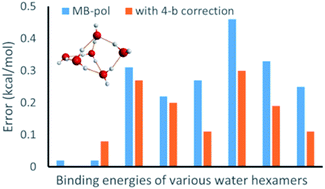A Δ-machine learning approach for force fields, illustrated by a CCSD(T) 4-body correction to the MB-pol water potential
Abstract
Δ-Machine learning (Δ-ML) has been shown to effectively and efficiently bring a low-level ML potential energy surface to CCSD(T) quality. Here we propose extending this approach to general force fields, which implicitly or explicitly contain many-body effects. After describing this general approach, we illustrate it for the MB-pol water potential which contains CCSD(T) 2-body and 3-body interactions but relies on the TTM4-F 4-body and higher body interactions. The 4-body MB-pol (TTM4-F) interaction fails at very short range and for the water hexamer errors up to 0.84 kcal mol−1 are seen for some isomers, owing mainly to 4-body errors. We apply Δ-ML for the 4-body interaction, using a recent dataset of CCSD(T) 4-body energies that we used to develop a new water potential, q-AQUA. This 4-body correction is shown to improve the accuracy of the MB-pol potential for the relative energies of 8 isomers of the water hexamer as well as the harmonic frequencies. The new potential is robust in the very short range and so should be reliable for simulations at high pressure and/or high temperature.



 Please wait while we load your content...
Please wait while we load your content...